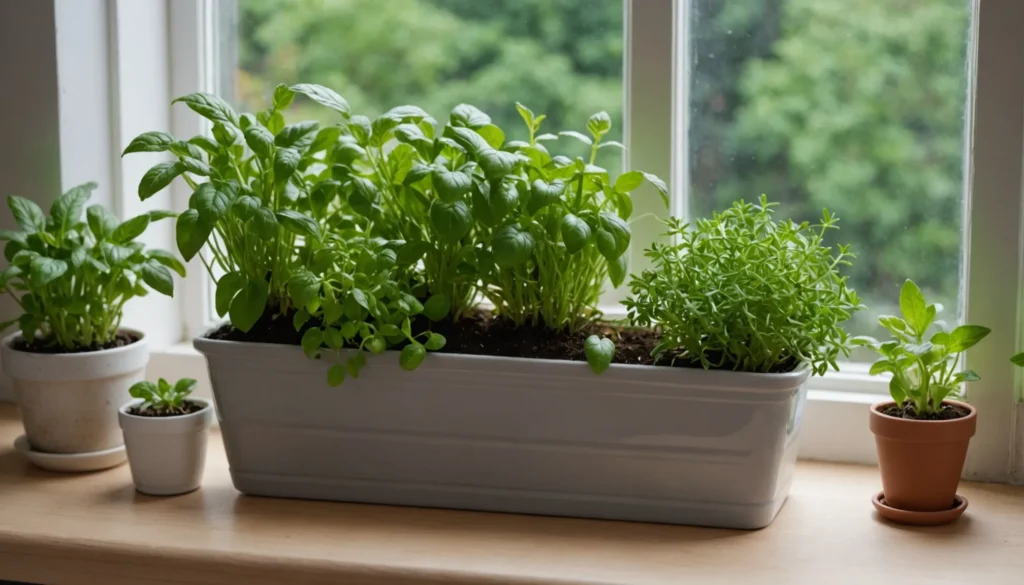Introduction
Indoor herb gardening is a rewarding and practical way to bring fresh flavors into your home while enjoying the therapeutic benefits of gardening. Whether you have a small apartment or a spacious house, growing herbs indoors allows you to cultivate fresh, organic ingredients for your kitchen all year round. This guide will walk you through everything you need to know about indoor herb gardening, from selecting the right herbs to ensuring they thrive in your indoor space.

Why Start an Indoor Herb Garden?
1. Fresh Herbs at Your Fingertips
One of the biggest benefits of indoor herb gardening is the convenience of having fresh herbs available at all times. No more last-minute grocery store runs—simply snip what you need right from your kitchen.
2. Cost Savings
Buying fresh herbs frequently can be expensive. Growing your own means you save money while enjoying fresh, organic herbs without preservatives or pesticides.
3. Enhances Home Aesthetics
An indoor herb garden adds greenery to your space, creating a more inviting and visually appealing environment.
4. Health Benefits
Gardening has been shown to reduce stress, improve mood, and even enhance air quality by filtering out pollutants.
Best Herbs for Indoor Gardening
Some herbs are better suited for indoor conditions than others. Here are some of the best herbs for indoor gardening in 2025:
1. Basil
A kitchen staple, basil thrives in warm, sunny spots and is perfect for adding flavor to pasta, salads, and sauces.
2. Mint
Easy to grow and highly aromatic, mint is perfect for teas, cocktails, and desserts. However, it spreads quickly, so consider keeping it in a separate container.
3. Chives
A hardy herb that grows well indoors, chives are great for garnishing soups, eggs, and potatoes.
4. Parsley
This biennial herb is a fantastic addition to many dishes, from soups to sauces. It prefers indirect sunlight and regular watering.
5. Thyme
A resilient herb that thrives in dry conditions, thyme pairs well with meats, stews, and roasted vegetables.
6. Rosemary
A woody herb that prefers bright light, rosemary adds a rich aroma to your kitchen and is excellent for seasoning meats.
7. Oregano
Commonly used in Mediterranean cuisine, oregano is easy to grow and adds depth to sauces and pizzas.
How to Grow Herbs Indoors: Step-by-Step Guide
1. Choose the Right Location
Herbs need plenty of light to thrive. Choose a south-facing window where they can receive at least 6-8 hours of sunlight daily. If natural light is insufficient, consider using LED grow lights.
2. Select the Right Containers
Use pots with drainage holes to prevent overwatering. Terracotta or ceramic pots are excellent choices because they allow airflow to the roots.
3. Pick the Right Soil
Use a high-quality, well-draining potting mix. Avoid garden soil, as it can be too dense and may contain pests or diseases.
4. Water Properly
Overwatering is one of the most common mistakes in indoor herb gardening. Water when the soil feels dry to the touch, but avoid waterlogging the roots.
5. Provide Proper Air Circulation
Good airflow prevents fungal diseases. Keep your herbs in a well-ventilated area and avoid crowding them together.
6. Prune Regularly
Regular harvesting encourages growth. Pinch off leaves and trim stems frequently to keep your herbs lush and productive.
7. Fertilize Occasionally
Use a balanced, organic fertilizer every few weeks to keep your herbs healthy and full of flavor.
Advanced Tips for Indoor Herb Gardening
Using Hydroponics for Herbs
Hydroponic gardening eliminates the need for soil and allows herbs to grow faster. Systems like AeroGarden make it easy for beginners to grow herbs indoors using nutrient-rich water.
Companion Planting
Some herbs grow better together. For example, basil and parsley thrive when planted side by side, while mint is best kept separate due to its aggressive growth.
Dealing with Pests Naturally
Aphids and spider mites can sometimes invade indoor herbs. Use neem oil or a mixture of dish soap and water to keep pests at bay.
Seasonal Herb Rotation
Some herbs prefer different seasons. Rotate your herbs based on the time of year to ensure a continuous supply.
Common Problems and Solutions
1. Leggy Herbs
- Cause: Insufficient sunlight.
- Solution: Move to a sunnier spot or use grow lights.
2. Yellowing Leaves
- Cause: Overwatering or poor drainage.
- Solution: Ensure proper drainage and allow the soil to dry between waterings.
3. Slow Growth
- Cause: Lack of nutrients.
- Solution: Fertilize with an organic herb-friendly mix.
How to Use Your Homegrown Herbs
Cooking with Fresh Herbs
Fresh herbs elevate the flavors of dishes. Use basil in Italian cuisine, rosemary with meats, and mint in beverages.
Drying and Preserving Herbs
To extend their shelf life, dry herbs by hanging them upside down in a dry, dark place. Store in airtight containers for later use.
Herbal Teas and Remedies
Many herbs have medicinal properties. Chamomile and mint make soothing teas, while thyme can be used for cold remedies.
Conclusion
Indoor herb gardening in 2025 is easier than ever, thanks to new advancements in gardening techniques and tools. Whether you’re a beginner or an experienced gardener, growing herbs indoors brings fresh flavors, health benefits, and aesthetic appeal to your home. By following these indoor herb gardening tips, you can create a thriving garden that provides year-round culinary and medicinal benefits.
FAQs
1. What are the easiest herbs to grow indoors?
Basil, mint, chives, and parsley are some of the easiest herbs to grow indoors.
2. Can I grow herbs without sunlight?
Yes! If you lack natural sunlight, you can use LED grow lights to provide the necessary light for your herbs.
3. How often should I water my indoor herbs?
Water when the soil feels dry to the touch. Most herbs prefer slightly dry conditions over constant moisture.
4. Do herbs need fertilizer?
Yes, but in moderation. Use a balanced organic fertilizer every 3-4 weeks for best results.
5. How can I prevent my herbs from dying?
Ensure they get enough light, avoid overwatering, use well-draining soil, and prune regularly to keep them healthy.
6. Can I grow herbs indoors year-round?
Yes! With proper care and lighting, herbs can thrive indoors all year long.
By following this guide, you’ll be well on your way to growing a lush, healthy indoor herb garden in 2025. Happy gardening!






